Grand Teton via Upper Exum
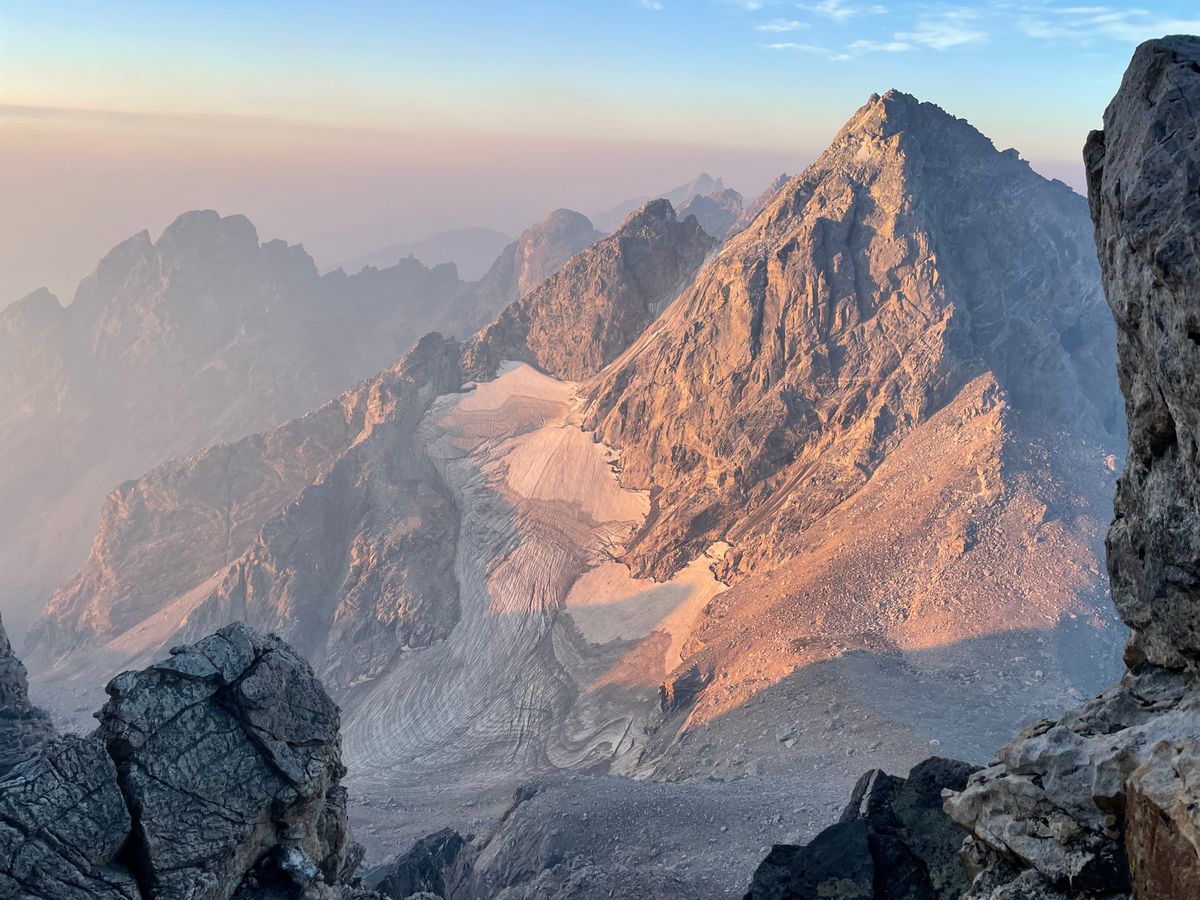
Labor Day, September 5, 2022:
- One-day ascent of Grand Teton via Upper Exum, a 5.5 climbing route.
- Round trip in just over 12 hours, 3:15am to 3:30pm.
Note: I may get commissions for purchases from links in this post.
Upper Exum is a 5.5 route up Grand Teton that starts midway up Exum Ridge. It involves the same approach as Owen Spalding up to Central Rib (between Lower and Upper Saddle). Owen Spalding is a 5.4, the easiest route up the Grand.
The Picnic triathlon was at the top of my list in summer 2022. It involves biking from Jackson to Jenny Lake, swimming across Jenny, then summiting the Grand via Owen Spalding and reversing the course. (46 miles of biking, 2.6 miles of swimming and 16 miles / 7,000' of hiking, running and climbing.)
After completing the Picnic in mid-August (trip report), I caught a bug for climbing and wanted to try some meatier routes in the Tetons.
One of my Wilderness First Responder ("WFR," pronounced /wo͝ofər/) classmates, Zack, offered to take me on Upper Exum. He grew up in Jackson, has close ties to Teton County Search and Rescue and works part-time for Exum Guides. In short, the perfect climbing partner for Upper Exum.
Note: I'd recommend a WFR, or at least a Wilderness First Aid course, for anyone spending significant time in the backcountry. I took a hybrid WFR in June 2022. It involved ~forty hours of online instruction and exams, followed by five days in person. One of the instructors was on our local search and rescue team, so we also got some behind-the-scenes access.
Preparation
We planned a one-day push. I was in good condition from the Picnic and my partner was in even better shape.
Since Upper Exum is an exposed 5.5, we planned to use ropes. I knew the rappelling basics and had a small climbing kit, but Upper Exum would be my first alpine climb using ropes to protect against falls.
Research
I read some articles and watched YouTube videos on trad climbing to get oriented. Trad, or traditional, climbing involves carrying and placing your own protection (e.g., cams and nuts), then clipping the rope in with quickdraws. By contrast, on sport routes climbers clip ropes into permanent anchors like bolts in the rock face, also via quickdraws.
For either type of climbing, someone belays the climber, extending slack as needed and ready to lock the rope in the event of a fall. The belayer could be at the bottom of a pitch, or at the top. If belayed from the bottom, the closest bolt or piece of gear to the climber catches their fall. If the belayer's at the top (e.g., the leader), they'll build a new anchor, effectively top roping the climber.
More context on protection
Cams: "Cams typically feature three or four curved pieces of aluminum, called cam lobes. When you pull the spring-loaded trigger wire, these chunks of metal retract and make the device narrower. This allows you to slide the unit inside a crack. When you release the trigger, the cam lobes expand to fit the rock. Placed correctly, cams offer excellent hold, particularly in places where passive pieces of gear will not, such as parallel-sided cracks." - REI
Nuts: "Nuts are metal wedges of various sizes and shapes, strung with cables, and designed to fit in constrictions in the rock. While not as glamorous as cams, these industrious passive pieces should not to be overlooked. They are relatively inexpensive and lightweight, and when placed well they are very reliable. Long before cams existed, climbers were summiting peaks with nothing but nuts on their rack." - REI
Quickdraws: Quickdraws are pre-attached carabiner and sling sets. One carabiner clips into anchor. The rope is then clipped into the other carabiner. Quickdraws reduce rope drag by straightening your rope's route. - VDiff
To safely trad climb, you need to understand rope systems and gear placement. My climbing experience was limited to top roping at the Driggs rock gym and knot practice before Owen Spalding. So I planned to rely on my partner's judgement for systems / gear placement, and use Upper Exum as a learning experience.
For the route, Wyoming Whiskey came to the rescue (again) with their Upper Exum guide. My partner had experience on the route and I knew the approach. So research was less extensively than for my Owen Spalding solo in August.
Wyoming Whiskey's overview of Upper Exum:
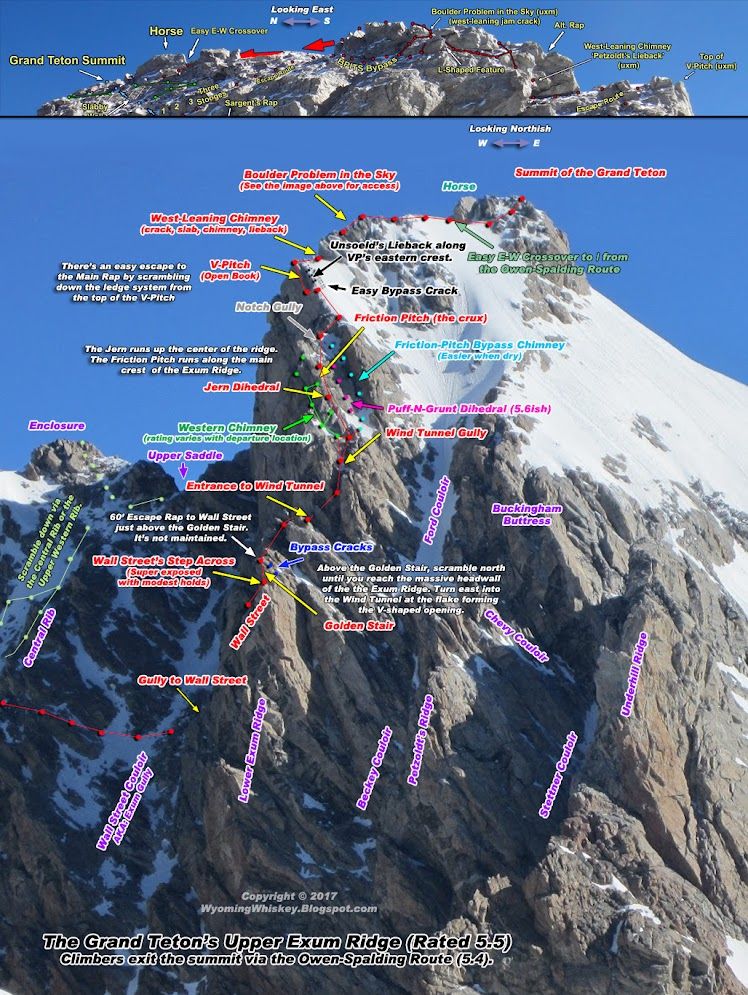
Gear
I used most of the same gear as for my Owen Spalding solo climbs. The exception was my climbing kit. We swapped my ATC belay device for one with assisted braking, and my daisy chain for a sling (borrowed both from my partner). I also left my prusik behind. My partner planned to be ready to fireman belay from the bottom if needed. We also brought one 70-meter, light rope.
I planned to carry the rope. My climbing partner would carry nuts and cams. 60 meters is the minimum required for Sargent's rappel, which bypasses most of the Owen Spalding downclimb.
- 15L REI vest pack
- Petzl climbing helmet
- Black Diamond Momentum harness
- Auto-locking belay device
- Sling
- Gloves from ACE Hardware
- Bear spray
- Black Diamond LED headlamp
- Sportiva TX4 approach shoes
- Blaze orange ball cap
- LifeStraw filtered water bottle (on my list to buy a flexible version that can fill up other containers, like a bladder)
- Food: GU gels, Clif bloks, Goldfish (highly recommend something salty to contrast all the sweet, sugary stuff), RX / Kate's bars, etc.
- Electrolyte powder
- Emergency gear: first aid kit, tourniquet, space blankets, Gorilla tape, baby powder (for chafing), Leatherman multi-tool, lighter, whistle, Ibuprofen, Voile straps (multiple uses)
Upper Exum
We settled on Labor Day for the climb. I was scheduled to fly back from the east coast the day before. The forecast looked clear.
I landed in Jackson at 9pm. The flight approached from the north, so the plane descended alongside the Tetons. It was a mild, clear night. I was stoked to think I'd summit that big rock in ~12 hours.
I loaded up on calories and organized gear. By 11pm, I slipped into bed, again using Olly sleep gummies that worked well ahead of the Picnic.
Approach
At 1:45am, my alarm jolted me out of bed. By 2am, I headed for the Lupine Meadows trailhead. I've gotten in the habit of leaving a cold brew in my truck the night before for the drive.
Visibility was low. It was noticeably darker than when I landed at 9pm. A dense fog seemed to settle on the valley floor overnight.
At 2:30am, I pulled into Lupine Meadows and got organized, while waiting for my partner. When he arrived, we swapped part of my climbing kit for his loaners. Lupine Meadows was far less busy than on my other late-night visits. It felt like we finally passed peak climbing season.
It was 50-60F, so running shorts, a sun hoodie and a vest did the trick.
By 3:15am, we hit the trail, headlamps guiding our way. Near the trailhead, we gave one climber beta on Owen Spalding. While I was out of town, it snowed a bit up high, so my partner tipped him to watch for ice. It was warm the past few days, so we weren't too concerned.
We only passed a few groups on the way up. By 4:30am, we reached the boulder fields at the start of Garnet Canyon and forked right for the Lower Saddle.
First light was 5:30am. At that point, we realized that fog was actually smoke. It must have blown in from a wildlife in Idaho.
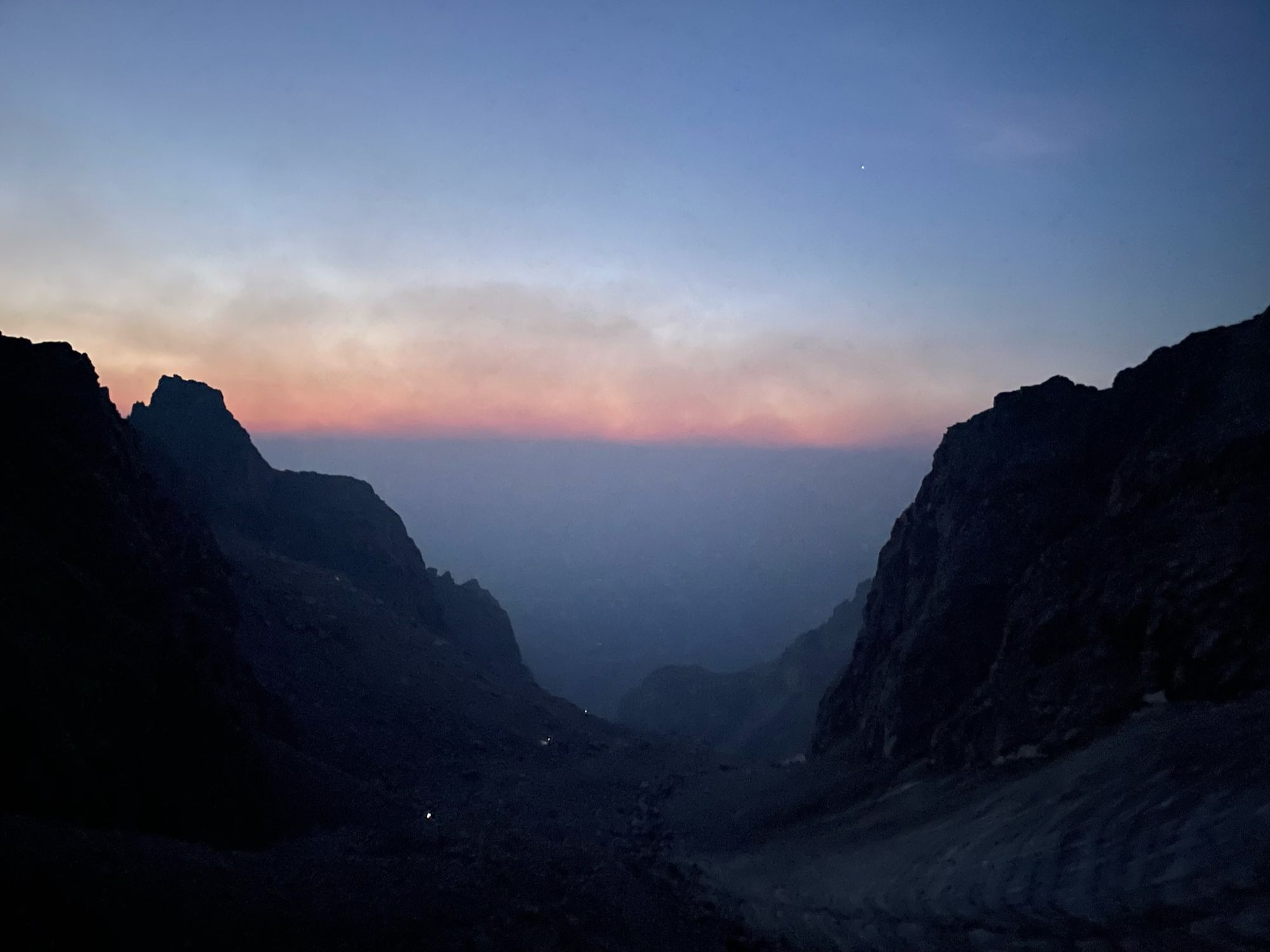

Dawn from just below (left) and on (right) the Lower Saddle
We approached Fixed Rope at ~6am, running into some of Zack's friends. (A native and Exum regular, he seemed to know everyone on the mountain.)
At 6:20am, we stopped at the spring to refill water bottles and eat breakfast. Wildfire haze hid the valley floor below, a spooky dawn. The Tetons were islands of rocks in a sea of smoke.
We continued past Exum's camp and up to the Needle. The approach to Upper Exum is the same as Owen Spalding up to the start of the Central Rib, between the Lower and Upper Saddle.
For more highlights on the approach, check out the Owen Spalding dry run section of my Picnic trip report. For a more comprehensive breakdown, I highly recommend the Wyoming Whiskey guide.
We passed left of the Needle and traversed Briggs' Slab to bypass Chockstone Chimney. I climbed Chockstone on my prior two Owen Spalding trips.
Wall Street to Golden Staircase
Wall Street is a 5-10' ledge leading from Wall Street Couloir (aka Exum Gully) to Exum Ridge. If you know where to look, it's easy to spot from the Lower Saddle. (I didn't.) The ledge is on the west side of the ridge, so it's shaded in the morning.
At 7:15am, we reached the top of Central Rib near the Lower Crossover. The sun lit up Middle and South Teton to our south. Smoke on the valley floor glowed orange. After crossing Central Rib, we downclimbed to the base of the gully closest to the bottom of Wall Street ledge. A quick up-climb deposited us on Wall Street. We found some loose rock, but otherwise easy climbing.

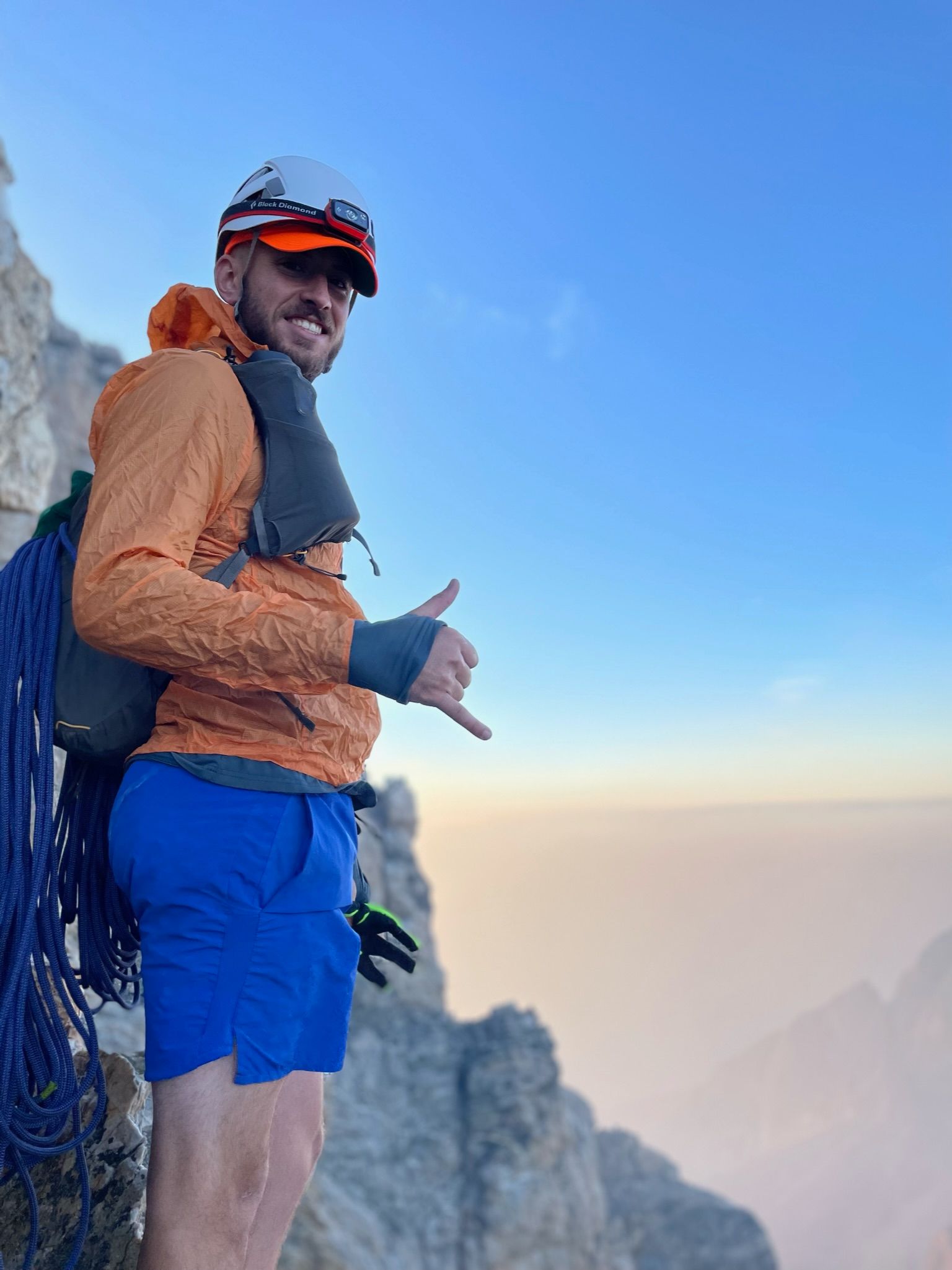

Overlooking Wall Street from the top of Central Rib
We walked up Wall Street toward the gateway to Upper Exum: Step Across. Legend has it, Glenn Exum leapt over the exposed gap during his 1931 first ascent.
At Step Across, the ledge narrows to 6" without good handholds above. I planned to apply upward leverage to an overhanging rock to increase friction from my shoes and side-step across. There's also a lower variation.
We roped up as a group ahead cleared the gap. We each stumbled into harnesses, tied into the rope with figure 8 knots and clipped on our gear. In the shade and not moving, it got chilly. We added windbreakers and gloves.
The group ahead finished at around 8am and Zack started climbing. He placed a cam just before Step Across, as I belayed him from the bottom. Once he had a stable position to belay me from the top, I followed and removed, or cleared, the protection he placed for reuse. I was protected by gear placed above the problem and/or his belay position.
I found the problem very awkward. Crouched down, feet on a narrow ledge, my butt hung over 2,000' of air. I hoped that upward pressure would lend enough friction to my approach shoes. (It did.) According to Wyoming Whiskey, it's a bit easier (and safer) to take the lower ledge variation.

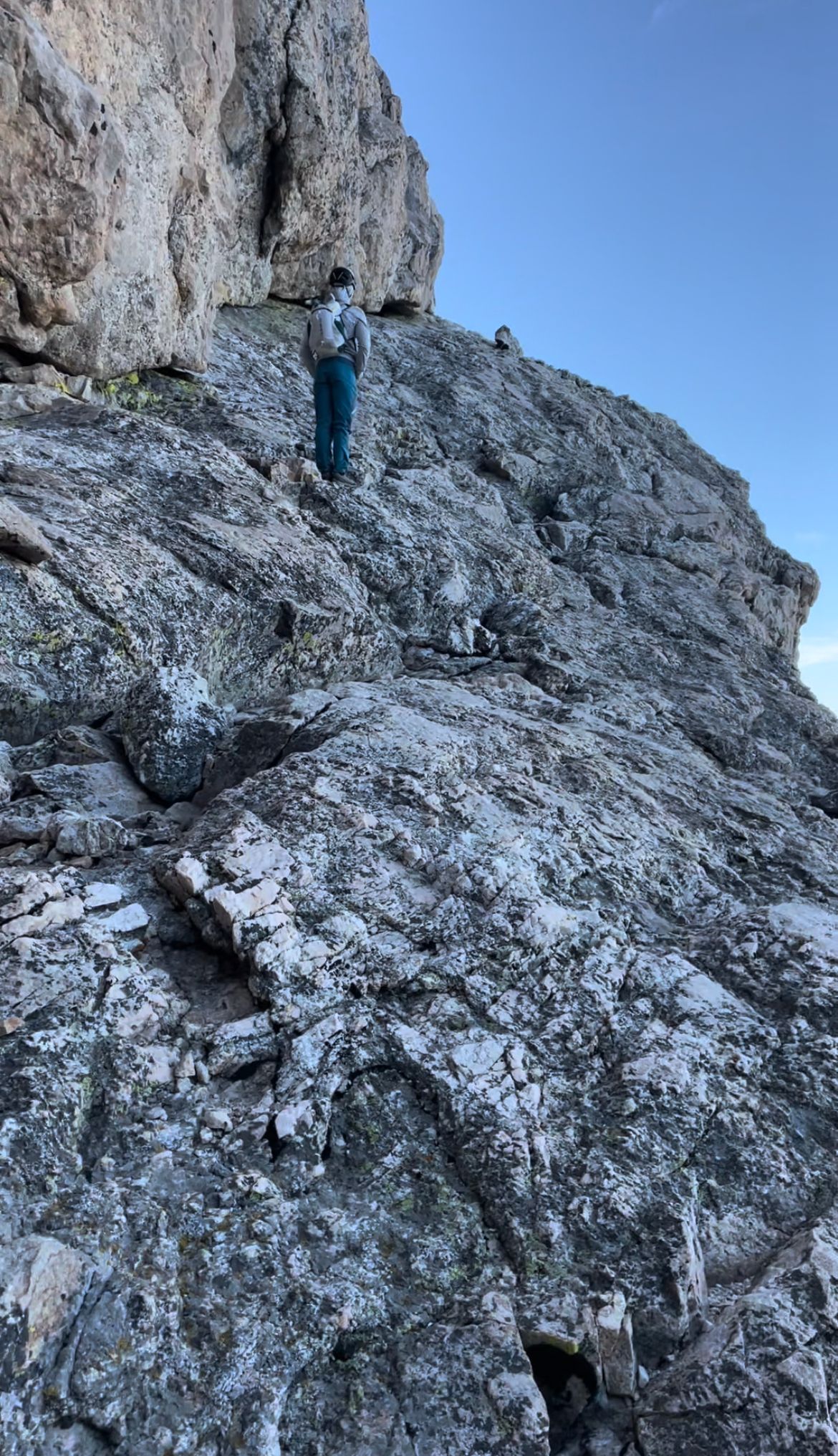

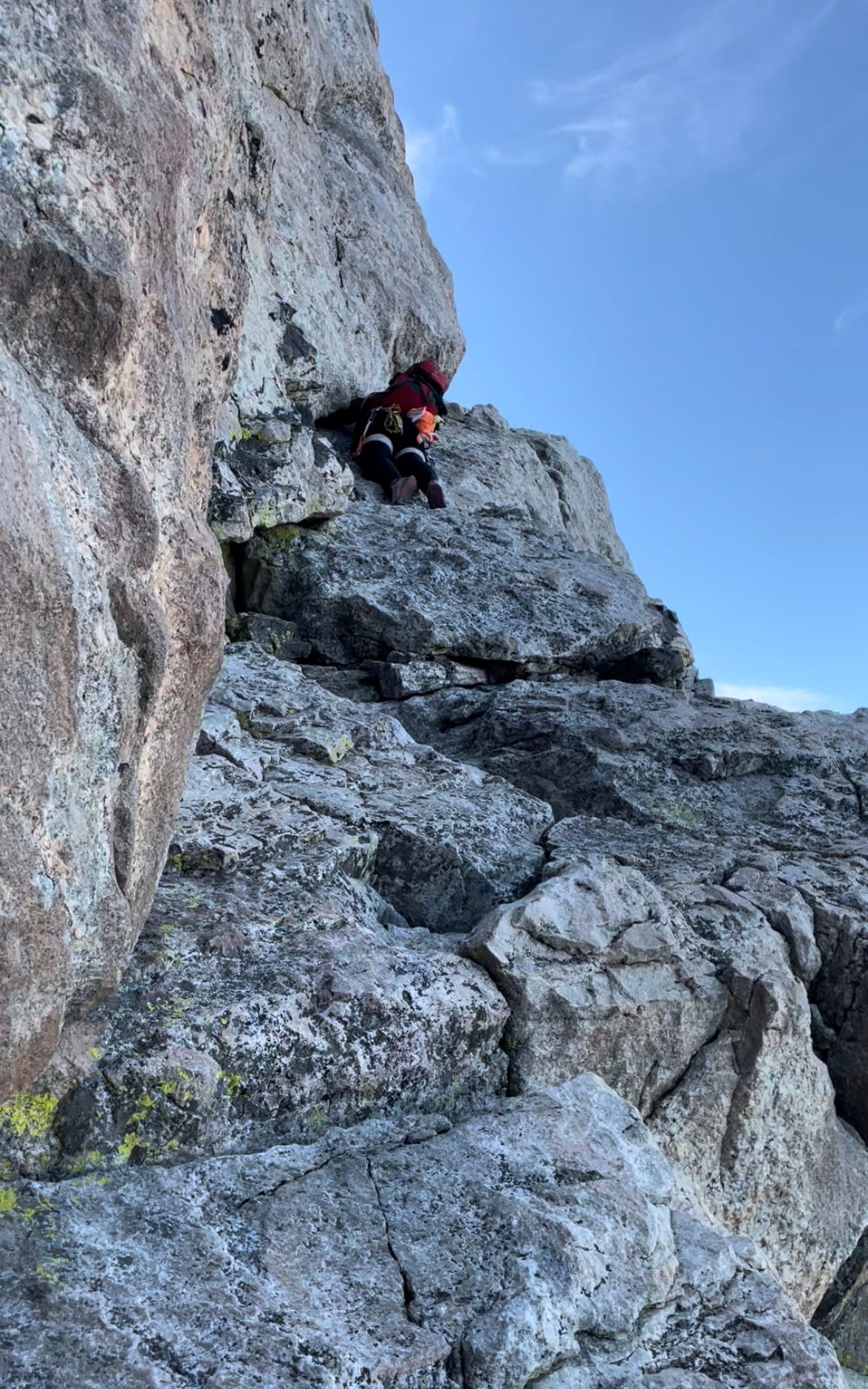
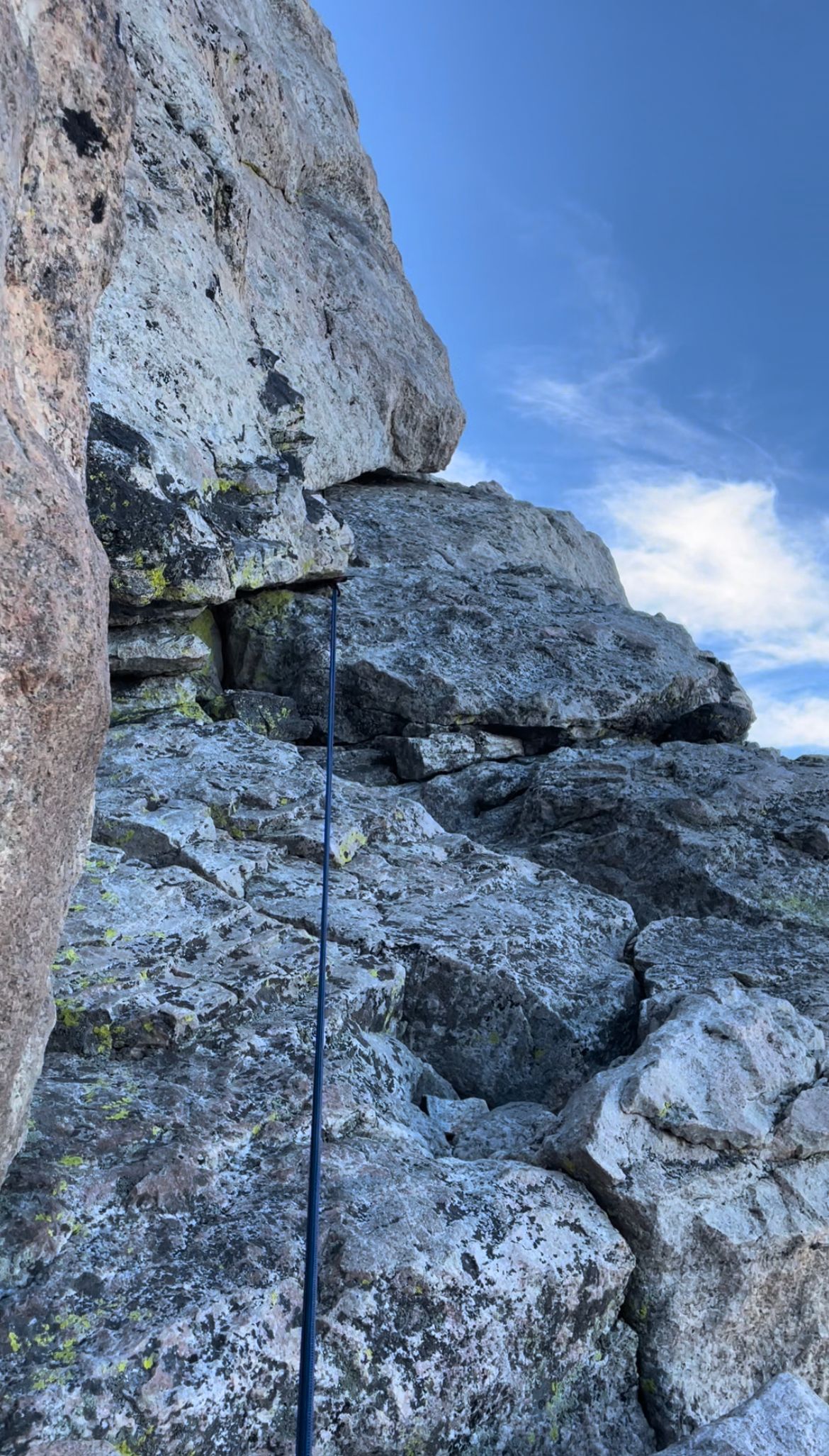
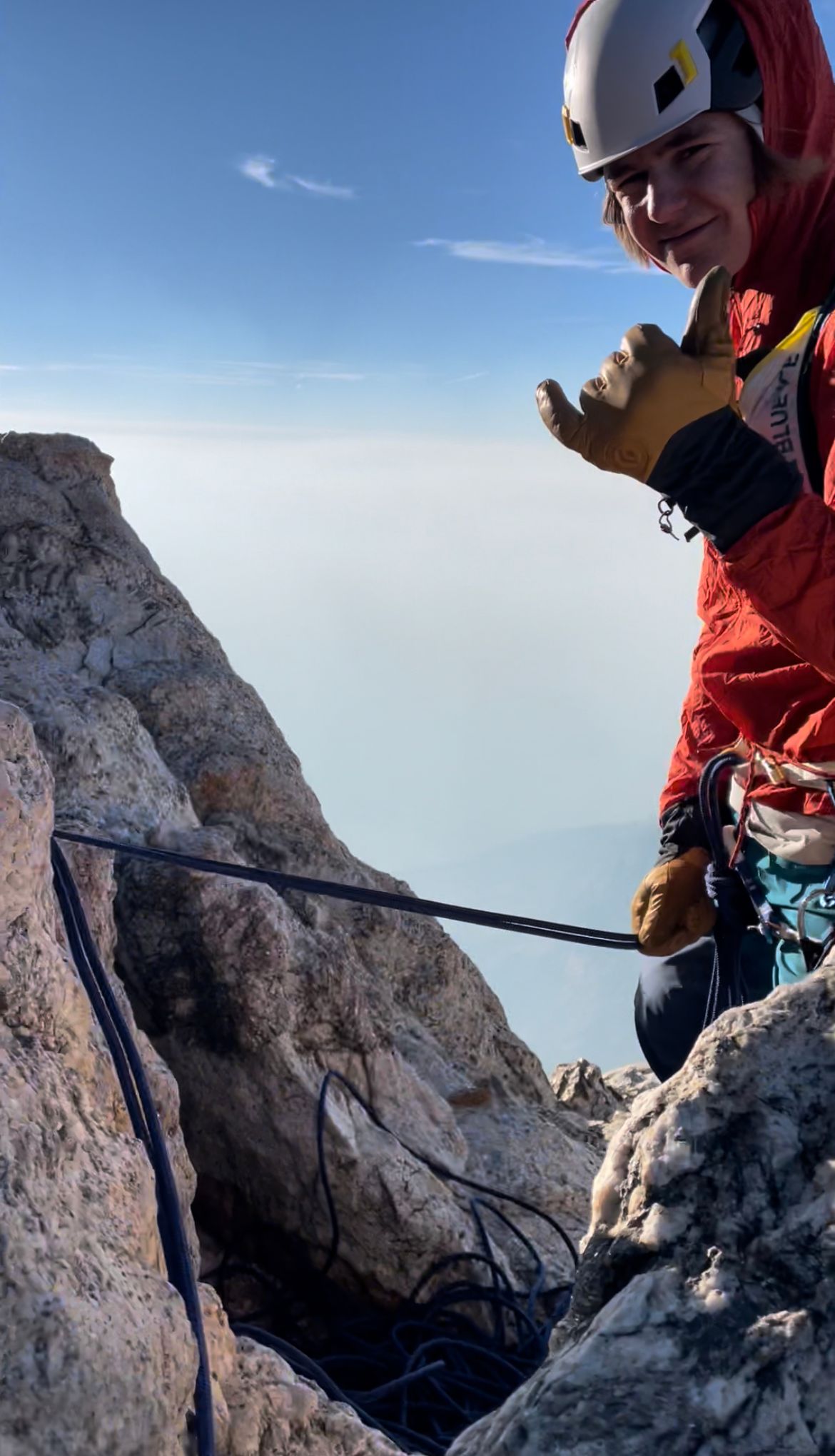
Wall Street (top left/middle); organizing gear (top right); Step Across (bottom)
Exum Ridge welcomed us with sunshine beneath Golden Staircase. Zack led up the Staircase, placing some cams as he climbed. I followed and cleared the cams. The handholds are small, but very grippy, and the face is exposed. It was my favorite section of the route.
Still warming up in the sun at the top, we reorganized gear. To shorten the rope, my partner coiled ~half around his body, then hitched it to his harness.
Wind Tunnel to Friction Pitch
We simul-climbed (aka climbing in unison) up to the appropriately named Wind Tunnel. There were a few fun boulder problems in the Tunnel. We ascended up the middle of the gully.
It was 8:25am when we reached the base of Friction Pitch. My partner extended the rope. We found a party ahead of us, so we climbed a crack just to the right.
Friction Pitch is the crux of the route (aka, the part responsible for its rating). That said, there are multiple variations, some above/below that 5.5 rating. You can even bypass Friction Pitch via a chimney to the right. Either way, Upper Exum is more challenging than Owen Spalding (longer and less obvious).
Again Zack led, placing protection. I followed and cleared. There weren't many handholds and footholds, so I relied on friction. It's important to keep your heel down to maximize surface area. (Zack reminded me.)
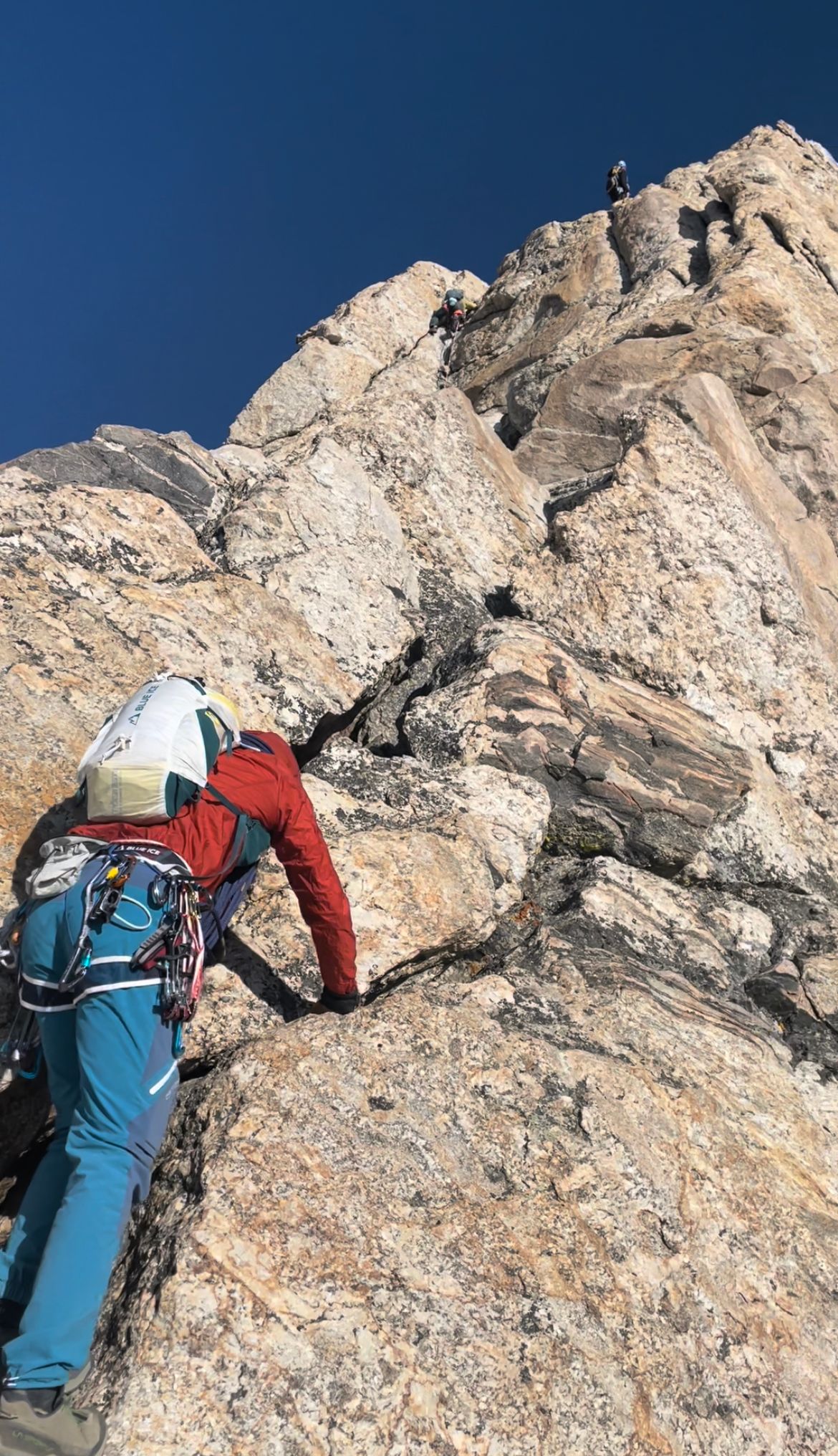
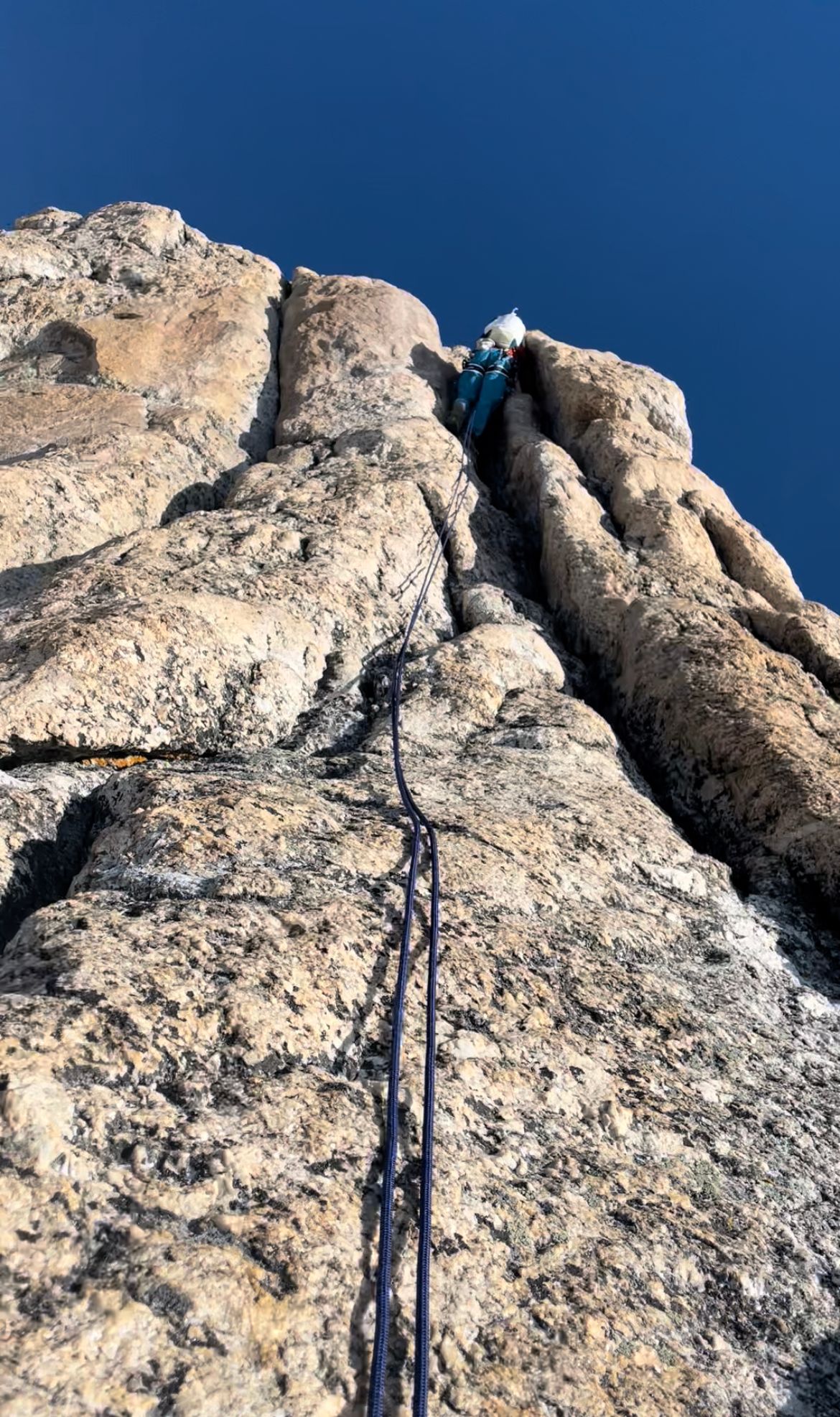
Friction Pitch
By 8:45am, we reached the top and transitioned back to simul-climbing with a short section of rope connecting us.
Boulder Problem in the Sky to the Summit
After Friction Pitch, we scrambled/climbed through Notch Gully, V-Pitch and then the West-Leaning Chimney. There were a couple tricky moves, but overall easy climbing with less exposure than other parts of the route.
Note: There are many variations on Upper Exum. Check out Wyoming Whiskey for detailed mark-ups.
By 9:30am, we tackled Boulder Problem in the Sky, my second favorite part of the route. It involved a few cruxy crack moves that take a minute to solve.


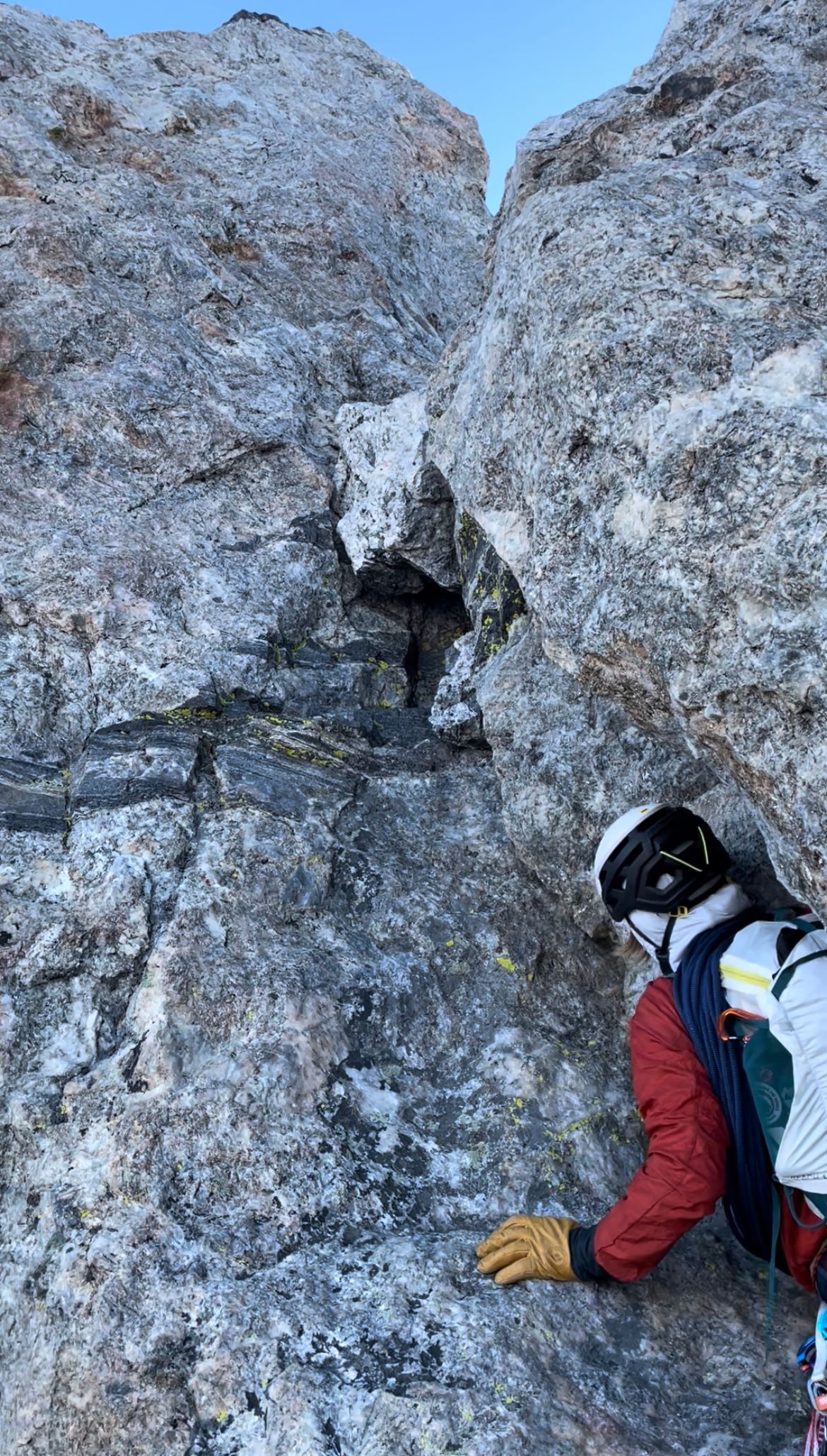
Headed to V-Pitch (left/middle); Boulder Problem (right)
After clearing the Boulder Problem, we scrambled to the summit. At 10am, we looked out on that sea of haze, blanketing Jackson Hole to the east and Teton Valley to the west. Mt. Moran emerged to the north and Middle, South and Buck to the south. We could barely make out Bradley and Taggart Lakes below.
We snapped some photos and settled down for lunch. A few other groups joined us. One climber was struggling, likely a combination of low blood sugar, dehydration and altitude. I gave him a GU gel. 15 minutes later, he started feeling better. Turns out, it was the same climber we met near the trailhead. He made it up Owen Spalding, but was pushing his limits.
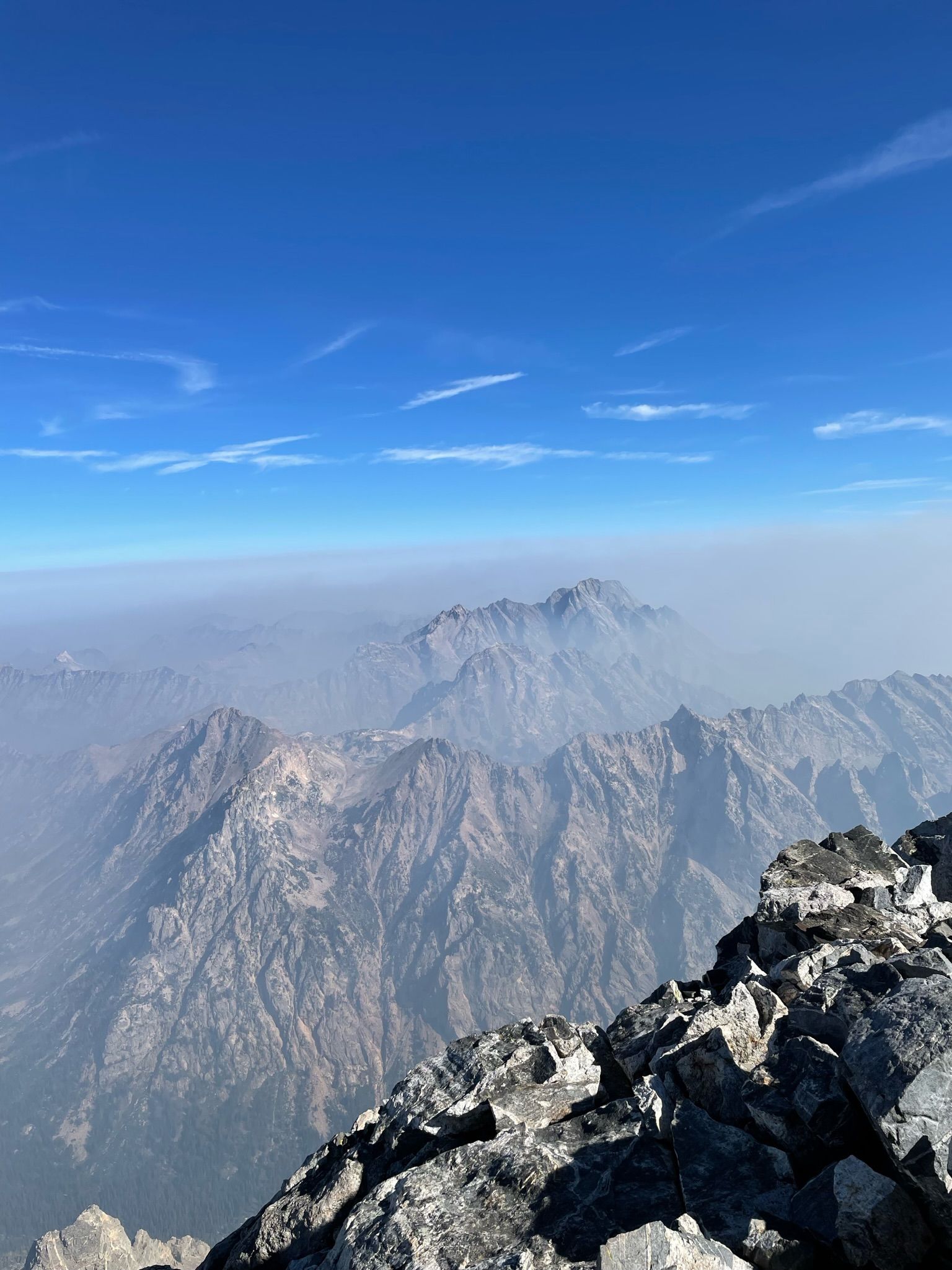
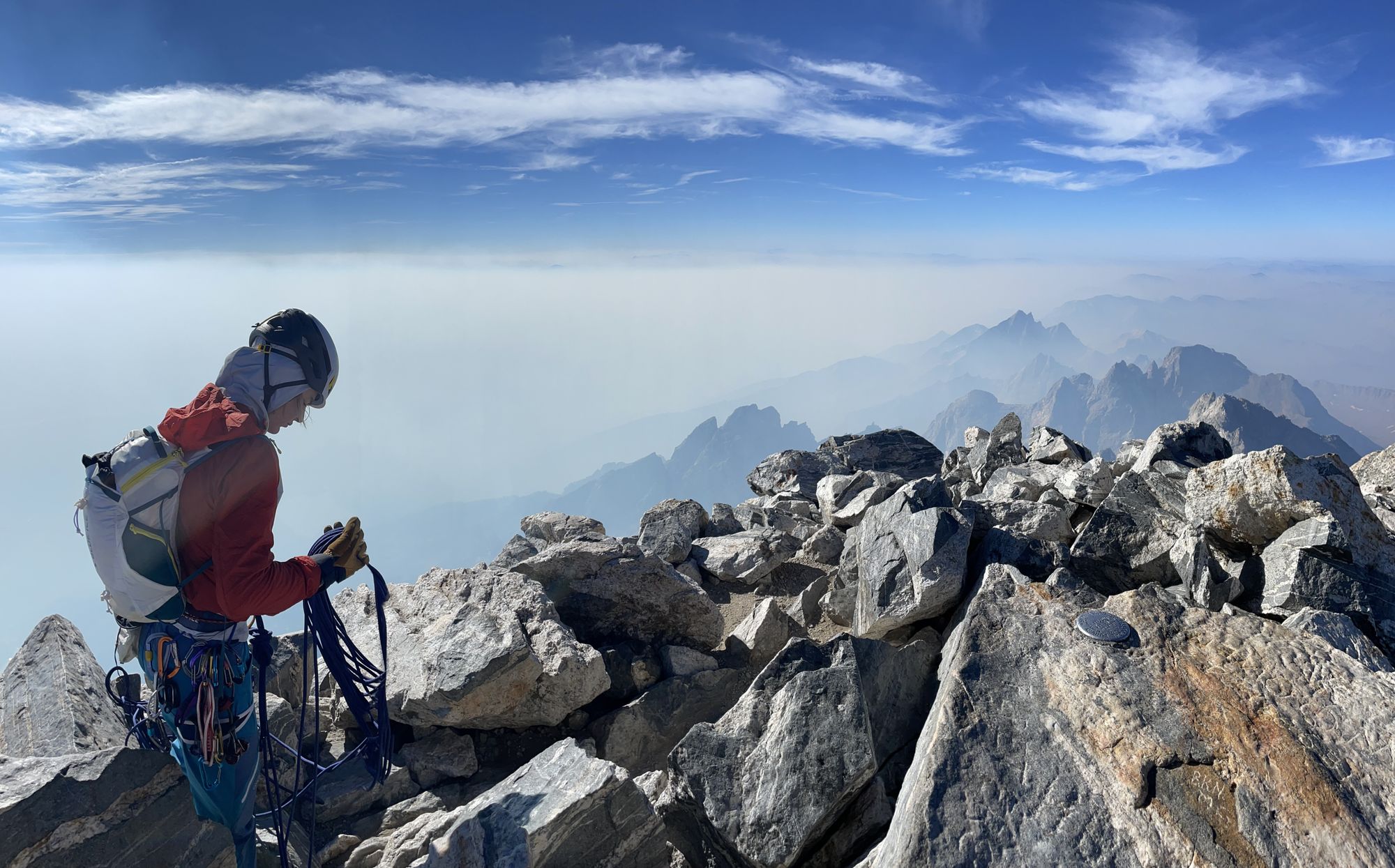
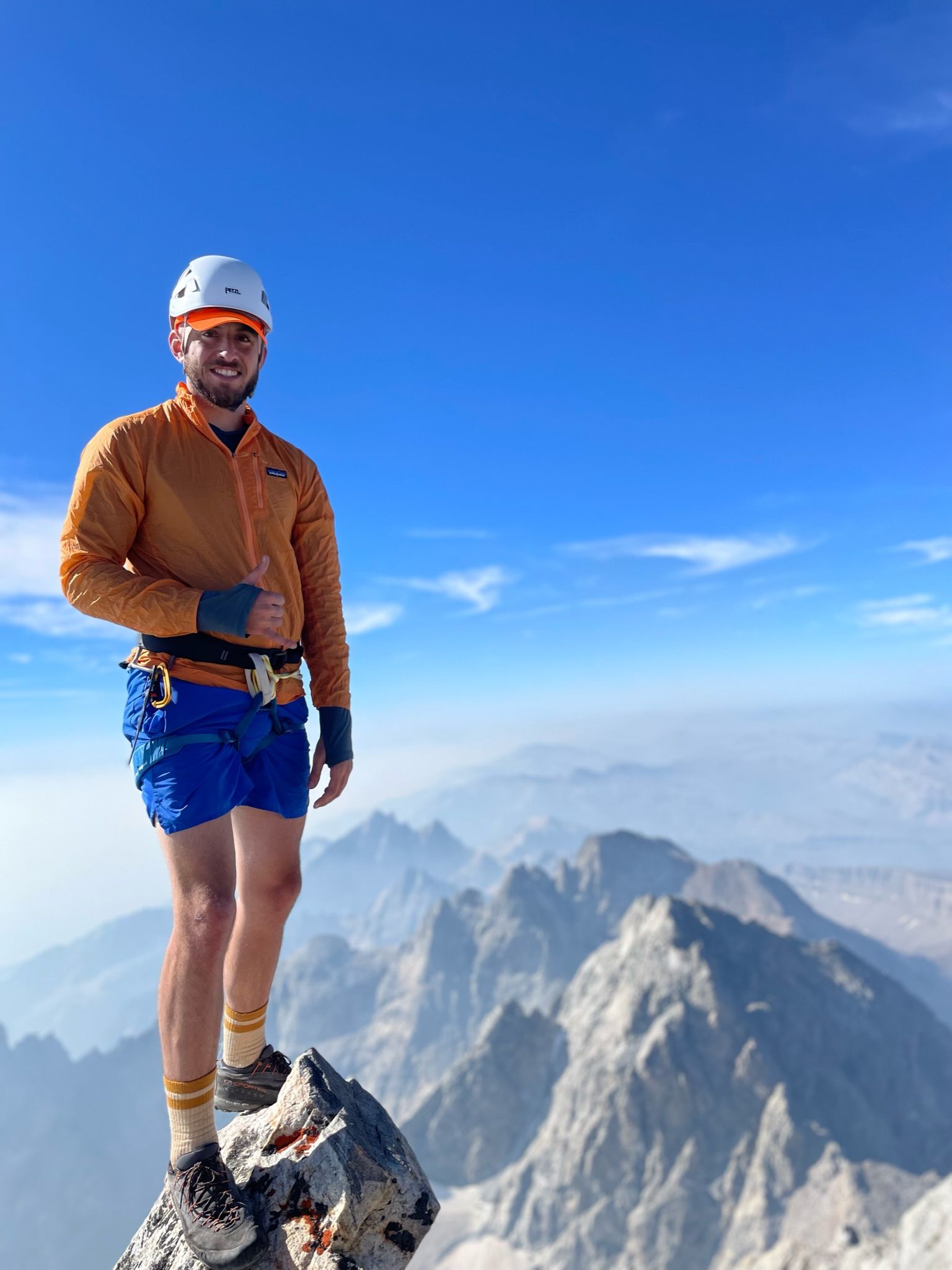
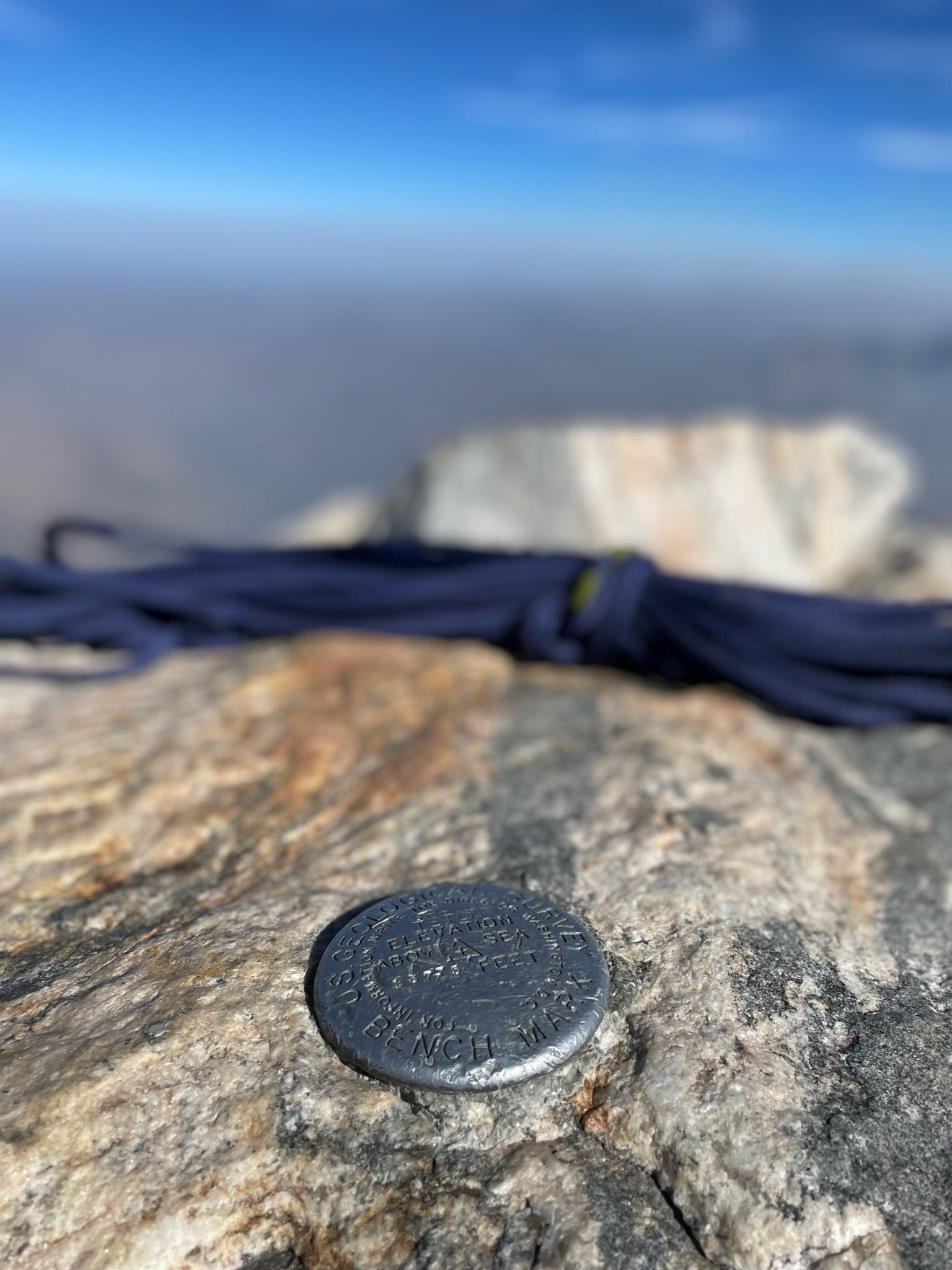
Grand Teton summit
Downclimb
At 10:45am, we started downclimbing. (Almost everyone descends via Owen Spalding versus Upper Exum.) We climbed down Sargent's Chimney, then started setting up to rappel at Sargent's Rappel.
Parties can skip the Owen Chimney / Catwalk, Double Chimney, Crawl and Belly Roll downclimbs by rappelling. On my last two ascents via Owen Spalding, I saved weight by skipping a rope, and thus, the rappel.
My climbing partner fed our rope through the anchor, tossed both ends off the edge and clipped in with his belay device. Once I felt slack in the line, I clipped in and followed. It's a 100' overhanging rappel, so you're suspending in the air as you drop down. It was my first overhang and a bit thrilling.
More context: How to Rappel by REI.
When I reached the bottom, we pulled our rope and cleared the rockfall zone. (Another party was rappelling behind us.) A climber at the base was debating whether to continue on Owen Spalding, so we gave him some tips and pointed out the route's start: Belly Roll.
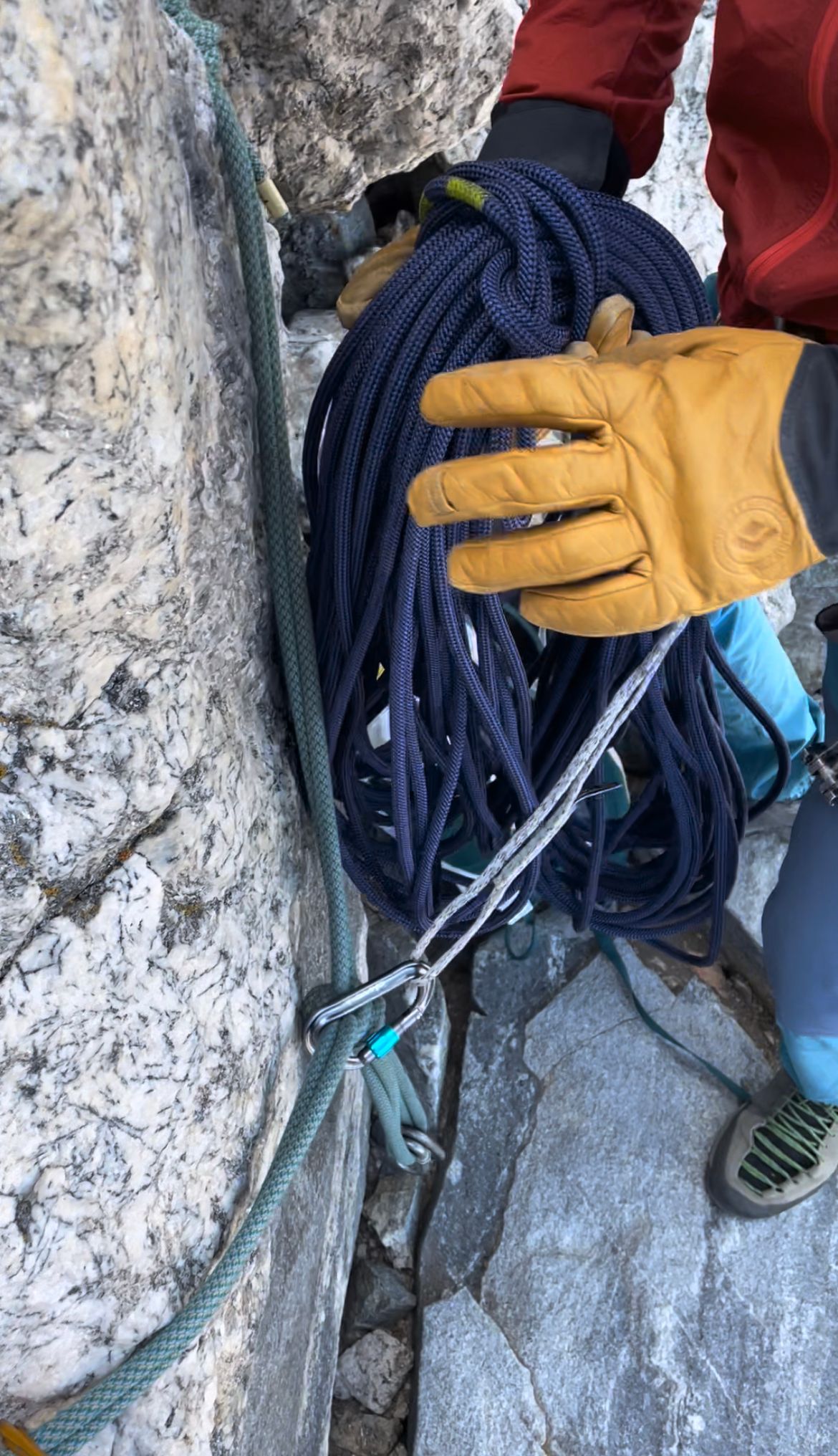
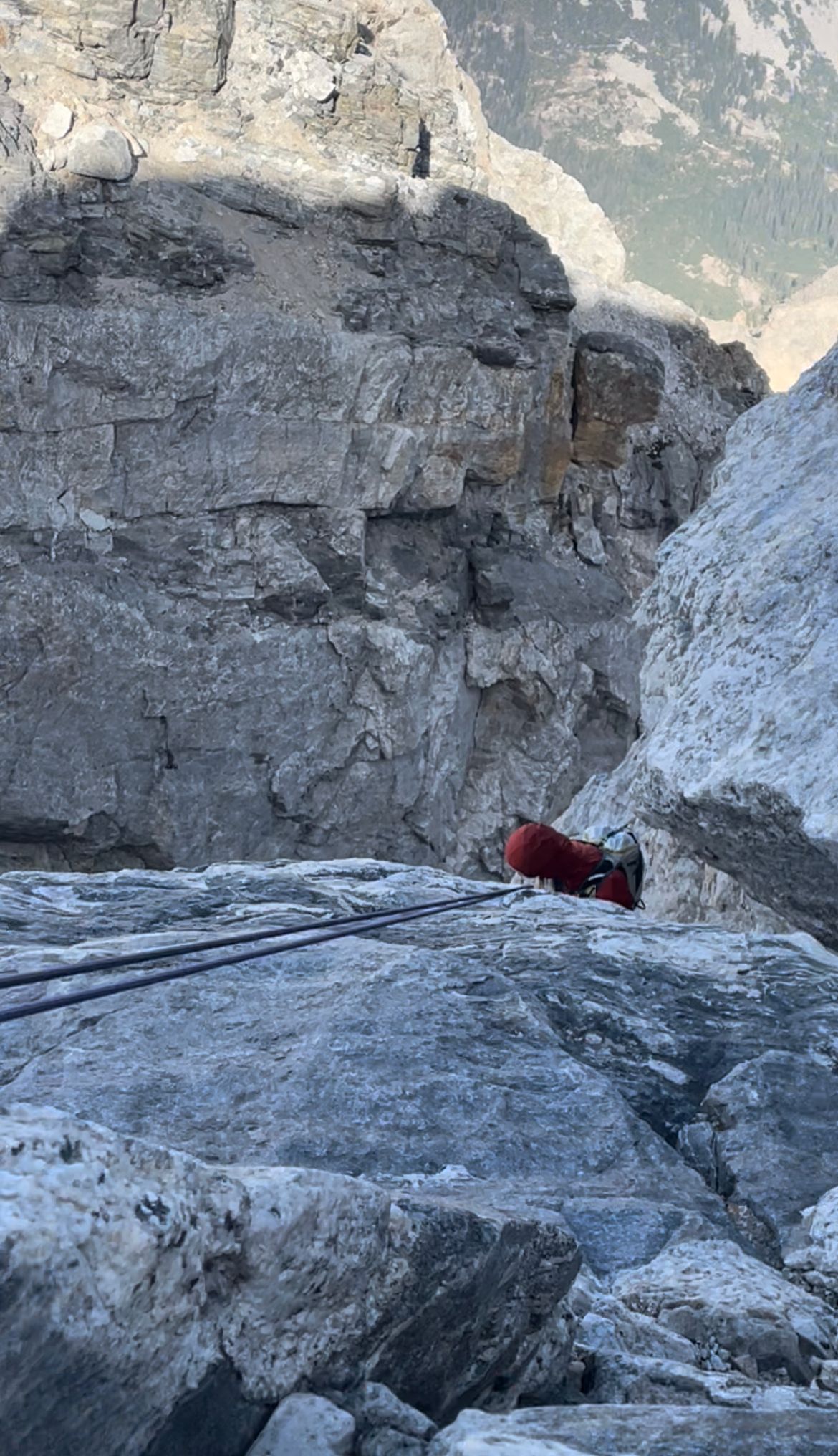
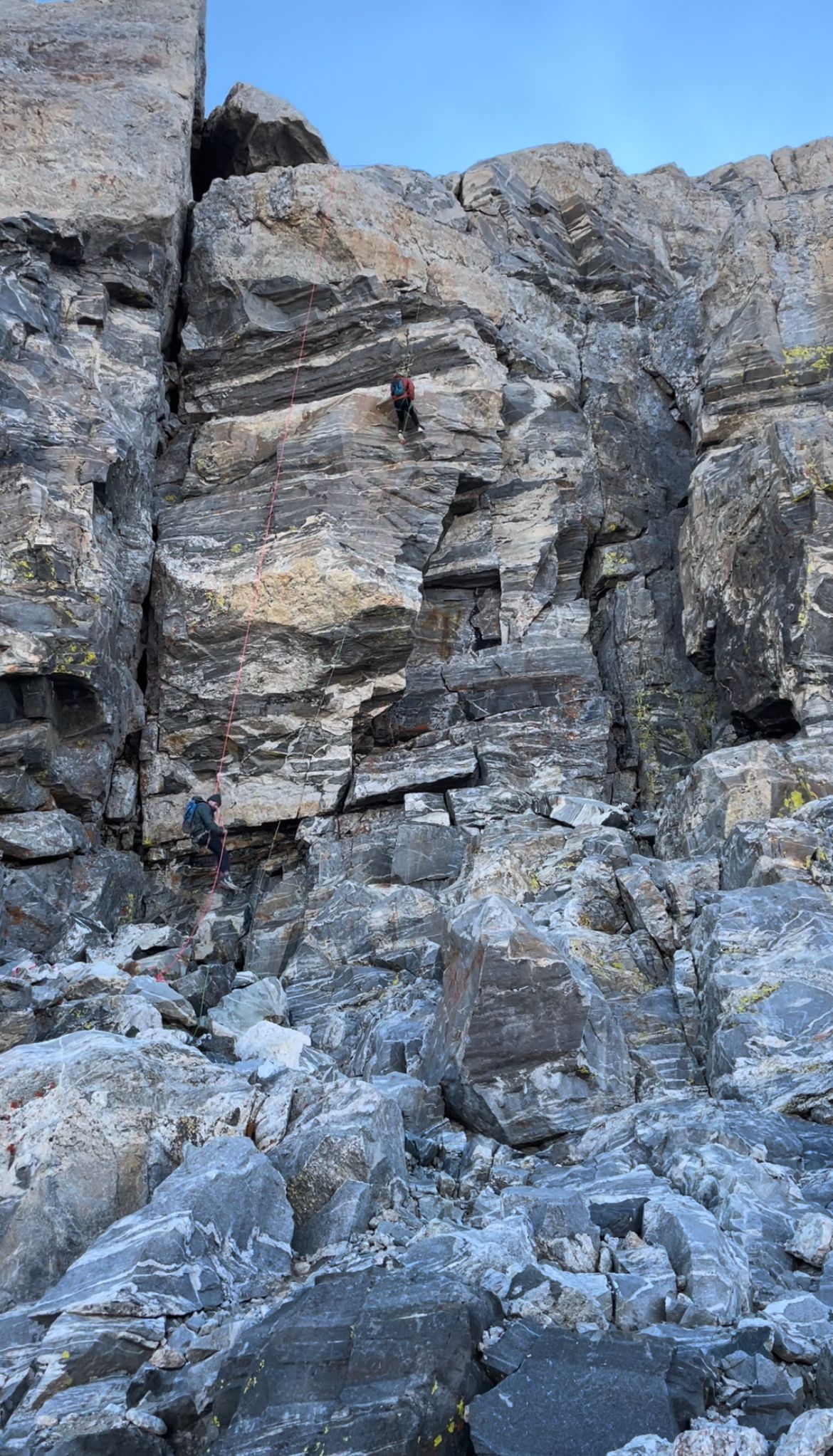
Sargent's Rappel
Then, we made our way back to the Lower Saddle. Again, I packed the rope and my climbing partner the protection. We stopped at the Lower Saddle spring. My knee was sore, so I popped a couple Ibuprofen.
The rest of the hike out was uneventful, a mix of walking and jogging. My climbing partner chatted with a few Exum buddies guiding parties into Garnet Canyon. For some reason, I didn't feel as confident with foot placement as on the Picnic, which was 8.5 hours roundtrip from Lupine Meadows. We maintained a slower pace.
Funny enough, the smoke largely dissipated by the time we reached the Meadows. That morning was probably the smokiest of the summer, a welcome contrast to 2021. But it only lasted ~12 hours.
At 3:15pm, we stumbled back to the Lupine Meadows trailhead. After breaking down our gear, we headed to Dornan's for pizza.
Up Next for the Grand
- Spring ski ascent/descent.
- Grand Traverse, ascent of multiple summits in the Cathedral Group.
- Full Exum Ridge, a 5.7 route.